The area around St. Mary Redcliffe
This is a wonderful church in the district of Redcliffe near Bedminster. I may be biased as I was christened here, but it really is a beautiful church. Queen Elizabeth I is said to have referred to it as
"The fairest, goodliest and most famous Parish church in England".
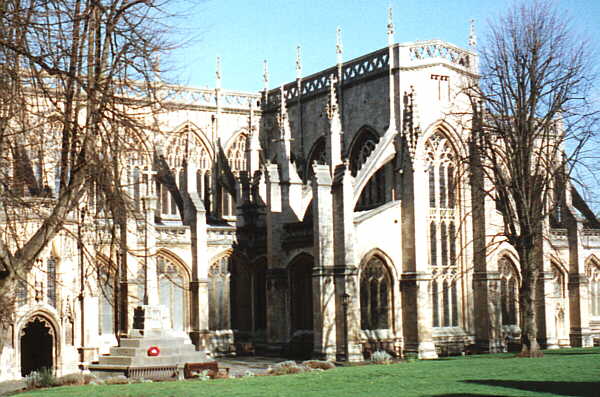
There was a church on this spot as early as the reign of Henry I (1100 - 1135), we know this as in 1115 he gave it to Salisbury Cathedral, but even before this there is a record of a priest in the Royal Manor of Bedminster. In 1190 Lord Robert of Berkeley gave it a water supply, a very valuable gift in the 12th Century. The water was piped from the Rugewell in Knowle. Ruge is an old name for ridge. The picture below is a plaque made to commemorate the event. Every year the vicar and churchwarden do the "Pipe Walk" from the church to the spring the water rises from, this entitles the church to various endowments. You can see Lord Robert's tomb in the church.
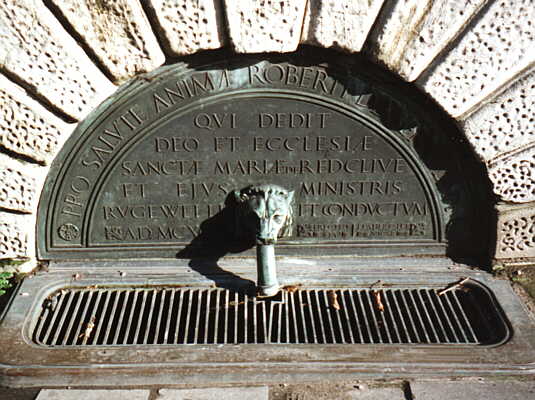
Plaque to commemorate the giving of the water supply
The wording translates as :-
"For the health of the soul of Robert of Berkeley, who gave to God and the Church of St. Mary Redcliffe and its ministers the Rugewell and conduit. AD 1190. Erected 1932."
This is not the original site of the conduit. It was originally located on the other side of the church in Pump Lane. The site it now occupies was where the old stocks were situated. The last use of these stocks, or any other, was in 1826, when two men were put in the stocks on Redcliff Hill for two hours for holding a drunken party in a nearby churchyard. There were stocks at St James as late as 1837, although no evidence survives of when they were last used.
The church was rebuilt between 1232 and 1246, this church was a lot larger than the earlier one, possibly not a lot smaller than the present one. A little later the church fell into disrepair and rebuilding was started by Simon de Burton, who went on to become mayor of Bristol three times. Progress was slow and by 1337 the work was being supervised by John Bohler, Thomas de Uphill and Geoffrey Fuller. In 1376 William Canynges more or less rebuilt it as the great church that stands today. The tomb of this great benefactor and his wife can be seen in the church. The church was very important in these days as the Merchant Venturers began and ended their voyages by praying at the shrine of Our Lady of Redcliffe, which was in the North Porch. William Canynges went on to become Mayor six times.
As the entry for 1376 in Adams's Chronicles of Bristol tells us "This year William Canings builded the body of Redcliff Church from the cross ends downwards."
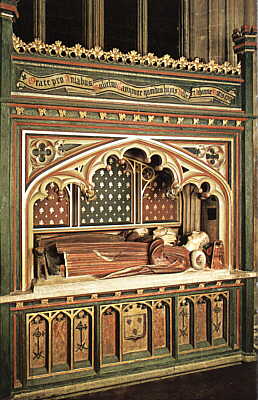
Tomb of Thomas Canynges
In the 15th Century the church contained six bells, which ranged in weight from 1300 lbs to 7,024 lbs. The church today boasts 14 bells, the largest now being 5,800 lbs.
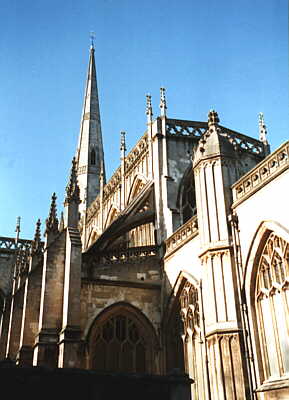
William Canynges' grandson also named William became Mayor in 1441 and repaired the church. In 1446 there was a great storm and, after being hit by lightning, the spire collapsed onto the nave. The damage was repaired, with no expense spared and with great attention to detail. The spire is a late addition not reaching its present height of 292 feet until 1872. Before then the church was topped by a short turret like affair. This William Canynges became Mayor five times. He was a busy overseas trader with interests in Prussia, Iceland and Finland, when relations between England and Denmark became strained he was granted special dispensation by King Christian I to continue trading in Scandanavia and Iceland. In 1461 he entertained the young King Edward IV at his house in Redcliffe Street. After the last time he was Mayor he took Holy Orders and died as Dean of Westbury in 1474.
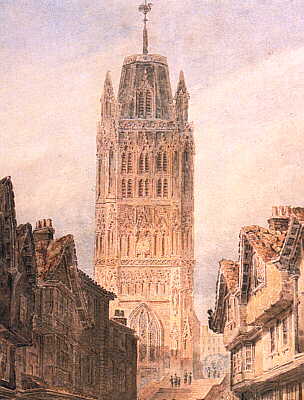
Detail from Redcliffe Street with St Mary Redcliffe
The illustration above is taken from a picture called Redcliffe Street with St Mary Redcliffe that can be seen in Bristol Museum and Art Gallery. It was painted in watercolours around 1810.
There are around 1,200 roof bosses all of which are different and each one a work of art in its own right. In 1740 the townswomen gave the church gold trinkets, these were melted down and used for their gilding.
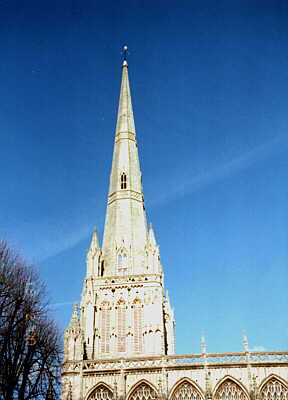
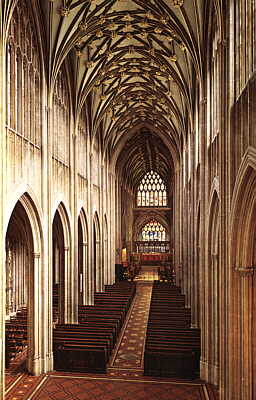
The Nave - showing many of the roof bosses
There are many famous people and interesting stories attached to the church, here are a few of them.
Giovanni Caboto, better known to us as John Cabot, in 1496 sailed from Bristol and discovered Newfoundland. A few years later he tried to return there, but failed, having got caught in the ice in Greenland. He eventually returned home bringing a four foot long whale bone with him. This is now displayed at the entrance of St John the Baptist's Chapel. Over the 500 years that the bone has been here a legend grew up that the bone was a rib from the giant Dun Cow. This creature, driven mad by a prolonged drought, terrified the residents of Bristol. It was finally killed by the Earl of Warwick with a single stroke of his sword. Perhaps this was the first case of Mad Cow Disease.
This chapel is also known as the American Chapel as it was restored by the Friends of St Mary Redcliffe in the United States. They also provided the kneelers that are embroidered with the arms of the States of the Union.
The tombs of Philip and Thomas Mede are in the north choir aisle. Philip became Mayor in 1458 whilst Thomas held the office three times.
The expression "weakest to the wall" originates here. Before around the 17th Century the church contained no pews - or hardly any other woodwork, and so people would stand or lean against the walls - hence giving rise to the expression.
This page created 23rd February 2000, last modified 24th January 2016